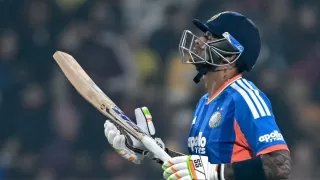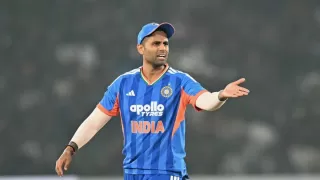Lakshya Sen Wins Epic 85-Minute Thriller to Reach Final

Lakshya Sen produced a performance of rare grit and athletic brilliance to outlast Chou Tien Chen in an 85-minute classic at the Australian Open Super 500 semifinals. The match — a 17-21, 24-22, 21-16 victory for Sen — was less a contest of raw power and more an epic of endurance, anticipation and jaw-dropping retrievals. From the outset, the two players turned rally after rally into high-tension theatre, leaving the crowd breathless and reminding everyone why badminton at its best feels like pure cinema.
What made the win remarkable was not just the final scoreline but the narrative arc of the match: Sen’s refusal to yield ground, his uncanny ability to retrieve impossible shots, and a mid-match surge that flipped momentum when it mattered most. Chou, the wily veteran who thrives on control and angle, produced moments of breathtaking precision, yet Sen’s relentlessness and those Bangalore-forged slap-drives repeatedly forced the issue back into his opponent’s half. The result was a contest that rewarded stamina, craft and the sheer will to keep the shuttle in play.
For Sen, this win is a meaningful marker in a season of near-misses and hard lessons — it’s his second final of 2025 (after Hong Kong) and another opportunity to convert great form into silverware. More than the trophy chase, the match underlined Sen’s evolution: he is no longer just an entertainer but a competitor who can grind, adapt and dismantle top-level opponents with a mixture of defence, anticipation and timely aggression.
Match Flow: From Steady Exchanges to Breathless Drama
The match opened with measured exchanges as both players sought rhythm and timing. Chou’s controlled placement and soft variations dominated early on, and he claimed the first set 21-17 by leveraging his superior net sense and tactical patience. Sen, although steady, found himself responding rather than dictating — a theme that changed dramatically as the match wore on.
The second set became the match’s emotional core. Trailing in patches and under constant probing, Sen refused to fold. He produced a string of long rallies that tested both players’ physical reserves and mental focus, culminating in a mid-set surge where his retrieving and slap-drives turned defence into attack. The set extended past regulation points, and Sen’s ability to stay aggressive yet composed in crunch moments saw him snatch a 24-22 win that shifted the balance irreversibly.
The decider saw Sen take full advantage of the psychological edge. Chou, having lost the momentum, fought valiantly but could not stem the tide as Sen’s retrieving began to sap his resolve. The 21-16 final scoreline reflected a combination of Sen’s improved shot selection and a visible dip in Chou’s cutting precision when pressed repeatedly by extended exchanges.
Key Moments That Defined the Contest
Several sequences stand out as turning points. A marathon 44-shot rally in the first set showcased Sen’s willingness to stay in the point; though he ultimately lost the opener, that rally sent a clear message about his intent. In the second set, a sequence where Sen produced three diving retrieves at three separate corners before sprinting to the net for a straight smash, illustrated both physical daring and match intelligence.
Another pivotal moment came late in the second set when Sen, under heavy pressure at 19-20, executed a perfectly-timed back-corner toss-drop followed by a precise forehand catch to force Chou into an error. That thrice-repeated pressure punctured Chou’s confidence and ultimately turned match point situations into opportunities for Sen.
The mental margins were tiny and decisive. When Chou had match points, Sen’s defence forced errors; when Sen had the initiative, his attacking choices were clinical. These micro-moments—retrieves, deceptive drives and timely smashes—collectively explained why the scoreboard ultimately favoured the Indian.
Sen’s Defensive Masterclass: Retrieving as a Weapon
What separated Sen from many of his contemporaries was the quality and consistency of his defensive retrieves. Where most players treat defence as damage control, Sen used it as an offensive platform — retrieving low, recovering quickly and converting defence into counter-attacks. His footwork, elasticity and split-second anticipation allowed him to stay alive in rallies that would have ended for others.
The signature slap-drive, often referenced as a “Bangalore-coded” shot, was deployed with devastating effect. It skidded flat and fast across the court, disrupting Chou’s timing and creating awkward angles for return. Combined with Sen’s low pickups and willingness to dive for shuttles, the slap-drive became an unexpected finishing stroke that earned crucial points in extended exchanges.
Physically, the toll was visible—Sen’s palms and legs bore the mark of an all-out effort—but so did the advantage it provided. By prolonging rallies and forcing Chou into repeated high-effort strokes, Sen gradually tilted the match toward his endurance strengths, turning defence into a sustainable long-game strategy.
Chou’s Control Game and Where It Faltered
Chou’s game, as always, was grounded in surgical control: exquisite placement, a compact swing and the ability to orchestrate angles with geometric precision. Early on, these attributes allowed him to dominate the tempo and build the lead in the first set. When he dictated the pace, Chou’s overhead variety and short cross smashes looked near-perfect.
However, the veteran’s control game was repeatedly tested by Sen’s relentlessness. Extended rallies forced Chou to generate more power and variation to break the pattern, which occasionally led to uncharacteristic errors. In high-pressure phases, Chou’s tendency to craft a killing opportunity sometimes gave Sen the window to counter—especially when the Taiwanese opted for riskier, wide-angle attacks rather than patience.
Ultimately, Chou’s fundamentals remained elite, but the match highlighted how even the most controlled game can be undermined by an opponent who combines tenacity with the capacity to flip defence into attack.
Tactical Nuances and Coaching Inputs
Both players and their teams showed tactical depth. Sen’s strategy was clear: extend rallies, force extra movement, and exploit the mid-court with flat, fast drives. Chou’s plan centred on controlling the front court and creating sharp angles to pull Sen out of position. Coaches on the sidelines reacted visibly, offering tactical nudges that each player intermittently adopted.
The timing of shot selection mattered: when Sen went for deeper clears and placed his slap-drives, he earned short-term rewards; when Chou mixed drop-shot patience with sudden cross-court kills, he regained control. The match thus became a continuous tactical conversation, with momentum shifts dictated by who could better implement the plan under fatigue.
These chess-like adjustments are what separates elite matches from ordinary contests. Both camps read the game and adapted, but Sen’s mid-set inventiveness and superior recovery ultimately trumped Chou’s meticulous control when the contest reached its most draining phases.
Physicality, Endurance and Mental Fortitude
Endurance was the quiet hero of this semifinal. At 85 minutes, the match was a gruelling test of aerobic fitness, muscle resilience and recovery. Sen’s shorter stature relative to some opponents required him to cover ground faster, yet his explosive rebounds and ability to regain balance from prone positions gave him the edge in dense exchange sequences.
Equally important was the mental resilience shown by both players. The ability to stay precise under pressure—hitting tight lines, resisting panic smashes and trusting footwork—separated the best from the rest. Sen’s repeated recovery from match-threatening situations revealed a maturity beyond his years; he not only survived but seized control at key junctures.
For Chou, the match exposed the small vulnerabilities that endurance can create: slight dips in speed, incremental loss of razor-sharp timing and momentary lapses that add up. These marginal declines are often decisive in long encounters, and here they contributed to Sen’s late dominance.
What This Win Means for Sen’s Season and Confidence
This victory is more than another final berth; it is a statement about Sen’s capacity to convert promise into consistent results. After a challenging season that saw missed targets like the World Tour Finals qualification, winning an 85-minute epic against a player of Chou’s pedigree will do wonders for Sen’s self-belief.
From a rankings and momentum perspective, the final could provide the springboard he needs to secure a maiden 2025 title and shift narratives around his consistency. But perhaps more valuable is the intangible: knowing he can outlast and out-think elite opposition across three grueling sets.
For fans and analysts alike, this match will be cited when discussing Sen’s growth. He now has evidence that he can mix artistry with grit, an essential combination for a player aspiring to greater heights on the world stage.
Fans, Reactions and the Bigger Picture
Spectators were treated to a near-flawless display of modern badminton: athleticism, artistry and tactical innovation. Social media buzzed with clips of Sen’s diving retrieves and slap-drives, while pundits praised the match as a masterclass in endurance. For the sport, matches like this are invaluable—they convert casual viewers into passionate followers and reaffirm the drama intrinsic to singles badminton.
The encounter also served as a reminder that badminton’s emotional peaks do not always come at the biggest events; sometimes a Super 500 semifinal produces theatre as compelling as any major final. For the development of the game, such contests widen the audience and showcase the depth of talent emerging from nations like India.
As Sen prepares for the final, the narrative will shift from recovery to readiness. Fans will expect more of the same—brisk retrievals, daring slap-drives and relentless heart. If his semifinal display is any guide, the final promises to be another exhilarating chapter in an already memorable season.
Conclusion: Cinema on Court
Lakshya Sen vs Chou Tien Chen was a match that rewarded patience, fitness and creativity. It proved that badminton can be as gripping as any film: full of twists, breathtaking sequences and a satisfying resolution that both honours skill and endurance. For Sen, the victory is a milestone; for spectators, it was a gift; and for the sport, it was yet another reminder that the best stories often come in the tightest of contests.
As the badminton world turns its eyes to the final, one certainty remains—Sen’s path to glory is paved by more than just power; it’s built on the long, unforgiving grind where defence becomes offense and tenacity makes champions.
Also Read: Ashwin Slams India A’s Shocking Super Over Exit Decision
Disclaimer
Possible11 is a sports news platform that provides live scores, player statistics, and tournament updates for informational and educational purposes only. We comply with the Online Gaming Bill, 2025 (India) and do not promote or engage with fantasy sports, betting, or real-money gaming platforms. All content is intended solely to enhance the sports experience. Possible11 is not affiliated with any fantasy or gambling applications and is not responsible for any financial gains or losses incurred on external platforms.












Give Your Feedback